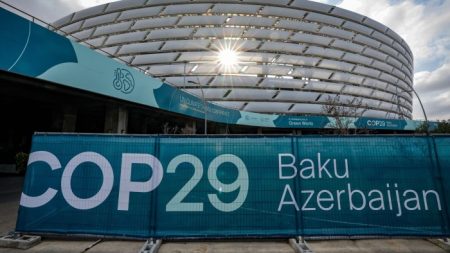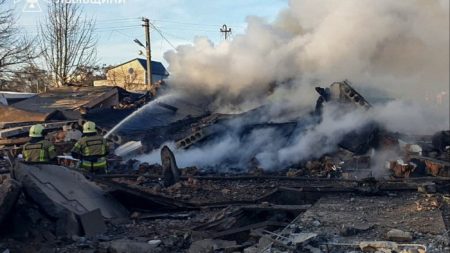Stay informed with free updates
Simply sign up to the War in Ukraine myFT Digest — delivered directly to your inbox.
Ukraine’s incursion into Russia aims to establish a “buffer zone” to prevent cross-border attacks into Sumy in Ukraine by Moscow’s army, President Volodymyr Zelenskyy said, as Kyiv’s forces blew up a third bridge in the Kursk region to strengthen its positions there.
On Sunday and into Monday, elite Ukrainian military units pressed ahead with their ambitious operation inside Kursk, which began almost two weeks ago. The Financial Times saw heavy weaponry, armoured vehicles and trucks carrying fresh troops streaming into the western Russian region.
Ukraine’s air force chief Mykola Oleshchuk published two videos showing air strikes on two bridges across the river Seym near the towns of Glushkovo and Zvannoe, which analysts said would hinder Russian military logistics and help Ukraine to consolidate its grip on roughly 1,100 sq km of territory.
On Monday morning, Russian military bloggers published photos purporting to show a collapsed third bridge in the town of Karyzh, which they said had been destroyed by Ukrainian forces. A representative from Russia’s Investigative Committee confirmed in a video address published by a Russian state television anchor that the bridge had been destroyed. Kyiv did not immediately claim responsibility.
In his evening address to the nation on Sunday, Zelenskyy laid out for the first time one of Ukraine’s strategic goals with the operation in Russia’s Kursk region saying “it is now our primary task in defensive operations overall: to destroy as much Russian war potential as possible and conduct maximum counteroffensive actions”.
He added: “This includes creating a buffer zone on the aggressor’s territory — our operation in the Kursk region.”
Before the incursion, Russia had targeted civilian and military infrastructure in the north-eastern Ukrainian region of Sumy with missile, drone and artillery attacks on a near-daily basis. The border area is also a point from which Russia launched its multipronged offensive against Ukraine in February 2022. Moscow’s army blasted its way through border crossings in Sumy en route to the regional capital of the same name and other cities further west.
“Everything that inflicts losses on the Russian army, Russian state, their military-industrial complex, and their economy helps prevent the war from expanding and brings us closer to a just end to this aggression — a just peace for Ukraine,” Zelenskyy said.

Nearly two weeks after Ukrainian troops smashed through the Kursk border, catching troops by surprise, Russia has struggled to respond. The Kremlin has ordered a “counterterrorism operation” in the region led by its federal security service, the FSB, and sent in young, inexperienced conscripts.
But they have so far failed to repel Kyiv’s forces, which captured several more small settlements. The Russian military has also used deadly glide bombs on its own territory to try to disrupt the operation while bungling a hastily organised civilian evacuation from scores of cities and towns through which Ukrainian forces have blazed a path.
Russian units that have arrived in the Kursk region as reinforcements are currently taking a defensive role and holding off further advances by Ukrainian forces, according to Ruslan Leviev, co-founder of the Conflict Intelligence Team (CIT), an independent war monitor conducting open-source investigations of the Russian military.
“We have not seen any attempts by Russian ground units to attack Ukrainian positions in the Kursk region,” he said.
In the meantime, according to Leviev’s observations, Ukrainian forces are primarily reinforcing their flanks as they attempt to advance in both directions along the Russian-Ukrainian border.

The Centre for Defence Strategies, a Kyiv-based security think-tank, said in an assessment overnight that Ukraine’s 103rd Territorial Defense Brigade had captured the village of Vnezapnoye and encircled Russian FSB border troops near Glushkovo.
The CDS said Ukrainian forces had seized control of “Tolpyno and Kolychevka, cutting off the Russian garrison in Korenevo from the main enemy forces”.
They also “captured Aleksandrovka and used it as a hub for deep raids towards Lgov and Rylsk”, deeper into Kursk region.
Zelenskyy said his commander-in-chief of the armed forces, General Oleksandr Syrsky, had briefed him on the evolving situation on the ground and confirmed the capture of more Russian troops who would be added to what the president called an “exchange fund”.
One of Ukraine’s objectives has been to take as many Russian prisoners as it can to be used to negotiate the release of more than 8,000 Ukrainians held captive by Moscow.
In his address, Zelenskyy said his troops “are doing great on all fronts”, and pleaded with the western nations on which Kyiv relies for arms and ammunition for “faster delivery of supplies”.
“There are no vacations in war. Decisions are needed, as are timely logistics for the announced aid packages,” Zelenskyy said. “I especially address this to the United States, the United Kingdom and France.”
Additional reporting by Max Seddon and Anastasia Stognei in Riga.
Read the full article here












